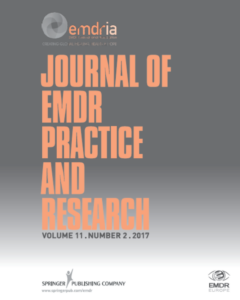A biologically inspired neural network model to gain insight into the mechanisms of post-traumatic stress disorder and eye movement desensitization and reprocessing therapy (Frontiers in Psychology)
This study used a biologically inspired computational model combined with real data from patients treated with EMDR to gain insights into PTSD mechanisms and to investigate how EMDR achieves trauma remission.
Read MoreEye-movement replay supports episodic remembering (Proceedings of the Royal Society B: Biological Sciences)
When we bring to mind something we have seen before, our eyes move in a sequential pattern very similar to the original encounter.
Read MoreIndividual prediction of trauma-focused psychotherapy response in youth with posttraumatic stress disorder using resting-state functional connectivity (NeuroImage: Clinical)
Study of biomarkers are available to assist clinicians in identifying youth with PTSD who are most likely to benefit from treatment.
Read MoreThe effect of EMDR versus EMDR 2.0 on emotionality and vividness of aversive memories in a non-clinical sample (European Journal of Psychotraumatology)
Hypothesis that EMDR 2.0 is more efficacious than standard EMDR and show a greater decrease in emotionality/vividness than standard EMDR.
Read MoreGood vibrations: Bilateral tactile stimulation decreases startle magnitude during negative imagination and increases skin conductance response for positive imagination in an affective startle reflex paradigm (European Journal of Trauma & Dissociation)
Testing the physiological and psychological mechanisms of bilateral stimuli while recalling traumatic memories in healthy subjects.
Read MoreA Model for the Flash Technique Based on Working Memory and Neuroscience Research (Journal of EMDR Practice and Research)
Research has shown that the Flash Technique (FT) appears to reduce memory-related disturbance and may reduce symptoms of PTSD.
Read MoreThe role of the thalamus in post-traumatic stress disorder (International Journal of Molecular Sciences)
Mini literature review on the potential contribution of the thalamus to the pathogenesis of PTSD & the validation of therapeutic approaches.
Read MoreInterhemispheric transfer of working memories (Neuron)
We studied how working memory is integrated across hemifields by recording neural activity bilaterally from lateral prefrontal cortex.
Read MoreClinical efficacy of EMDR in unipolar depression: Changes in theta cordance (Psychiatry Research)
EMDR may be efficacious in treating unipolar depression. The dorsolateral prefrontal cortex Theta Cordance may be linked to depression.
Read MoreTrauma-focused psychotherapy response in youth with posttraumatic stress disorder is associated with changes in insula volume (Journal of Psychiatric Research)
Study on the relationship between treatment response and alternations in brain structures associated with PTSD in children and adolescents.
Read More


